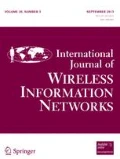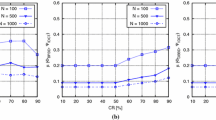Abstract
We propose in this paper, an optical wireless communicating accelerometer-based system for physical activity level monitoring. Optical wireless technology presents the advantage to be secure regarding electromagnetic interference, low-cost and easy to deploy. Considering a mobile patient, we theoretically investigate the performance in terms of packet failure in a specific environment. We study in particular the impact of the optical source directivity, the emitted optical power, the position of the motion sensor device on the body, and the number of optical receivers fixed on the room ceiling. The theoretical results are compared with experimental measurements for several configurations using a custom-made wearable communicating device. This permits validating optical wireless technology efficiency for physical activity monitoring and showing that it exists an optimal value of half-power angle of the transmitter to insure the optical wireless performance whatever the coverage and the height of the device over the body are. At last, we illustrate the trade-off between emitted power and number of active receivers.













Similar content being viewed by others
References
S. Gallanagh, et al., Physical Activity in the Prevention and Treatment of Stroke, ISRN Neurology, Vol. 2011, Article ID 953818, 2011. doi:10.5402/2011/953818.
A. Letombe, et al., Early post-stroke physical conditioning in hemiplegic patients: A preliminary study, Annals of Physical and Rehabilitation Medicine, Vol. 53, No. 10, 2010. doi:10.1016/j.rehab.2010.09.004.
C. V. C. Bouten, K. T. M. Koekkoek, M. Verduin, R. Kodde and J. D. Janssen, A triaxial accelerometer and portable data processing unit for the assessment of daily physical activity, IEEE Transactions on Biomedical Engineering, Vol. 44, No. 3, pp. 136–147, 1997. doi:10.1109/10.554760.
K. Y. Chen and D. R. Bassett Jr., The technology of accelerometry-based activity monitors: Current and future, Med. Sci. Sports Exerc., Vol. 37, pp. 490–500, 2005.
M. Periyasam and R. Dhanasekaran, Electromagnetic interference on critical medical equipments by RF devices, 2013 International Conference on Communications and Signal Processing (ICCSP), Melmaruvathur, pp. 78–82, 2013. doi:10.1109/iccsp.2013.6577019
Victoria S Benson, Kirstin Pirie, Joachim Schüz, Gillian K Reeves, Valerie Beral, Jane Green, and for the Million Women Study Collaborators, Mobile phone use and risk of brain neoplasms and other cancers: prospective study, Int. J. Epidemiol. first published online May 8, 2013. doi:10.1093/ije/dyt072.
J. M. Kahn and J. R. Barry, Wireless infrared communications, Proceedings of the IEEE, Vol. 85, No. 2, pp. 265–298, 1997.
J.B. Carruthers, Wireless infrared communications. Wiley Encyclopedia of telecommunications, Wiley, New York, 2003.
K. Borah, et al., A review of communication-oriented optical wireless systems, EURASIP J. Wirel. Commun. Netw. Vol. 91, 2012. doi:10.1186/1687-1499-2012-91.
H. Elgala, R. Mesleh and H. Haas, Indoor optical wireless communication: potential and state-of-the-art, IEEE Communications Magazine, Vol. 49, No. 9, pp. 56–62, 2011. doi:10.1109/MCOM.2011.6011734.
S. Arnon, et al., Advanced Optical Wireless Communication Systems, Cambridge University PressCambridge, 2012.
Z. Ghassemloy, W. Popoola, and S. Rajbhandari, Optical wireless communications, system and channel modeling with MATLAB ®, ISBN 978-1-4398-5188-3, pp 11–18, 2013.
S. S. Torkestani, S. Sahuguede, A. Julien-Vergonjanne and J. P. Cances, Indoor optical wireless system dedicated to healthcare application in a hospital, IET Communications, Vol. 6, No. 5, pp. 541–547, 2012. doi:10.1049/iet-com.2010.1116.
W. Noonpakdee, Adaptive wireless optical transmission scheme for health monitoring system, 2013 IEEE Third International Conference on Consumer Electronics-Berlin (ICCE-Berlin), Berlin, pp. 161–164, 2013. doi:10.1109/ICCE-Berlin.2013.6698016.
P. Toumieux, L. Chevalier, S. Sahuguède and A. Julien-Vergonjanne, Optical wireless connected objects for healthcare, Healthcare Technology Letters, Vol. 2, No. 5, pp. 118–122, 2015. doi:10.1049/htl.2015.0028.
E.M. Tapia, et al., Real-Time Recognition of Physical Activities and Their Intensities Using Wireless Accelerometers and a Heart Rate Monitor, 2007 11th IEEE International Symposium on Wearable Computers, Boston, MA, pp. 37–40, 2007. doi:10.1109/ISWC.2007.4373774
W. D. McArdle, et al., Exercise physiology: energy, nutrition and human performance, vol. 3rd, Lea and FebigerPhiladelphia, 1991.
A. Goldsmith, Wireless communications, Cambridge University PressCambridge, 2005.
M. Paksuniemi, H. Sorvoja, E. Alasaarela and R. Myllyla, Wireless sensor and data transmission needs and technologies for patient monitoring in the operating room and intensive care unit, 2005 IEEE Engineering in Medicine and Biology 27th Annual Conference, Shanghai, pp. 5182–5185, 2005. doi:10.1109/IEMBS.2005.1615645.
A. Behlouli, et al., Efficient simulation of optical wireless channel, Application to WBANs with MISO link, Procedia Computer Science, Vol. 40, pp. 190–197, 2014.
D. Wu, Z. Ghassemlooy, W. Zhong, et al., Effect of optimal lambertian order for cellular indoor optical wireless communication and positioning systems, Optical Engineering, Vol. 55, No. 6, p. 066114, 2016.
Author information
Authors and Affiliations
Corresponding author
Rights and permissions
About this article
Cite this article
Le Bas, C., Sahuguede, S. & Julien-Vergonjanne, A. Theoretical and Experimental Approach for the Design of an Optical Wireless Physical Activity Monitoring System. Int J Wireless Inf Networks 24, 65–77 (2017). https://doi.org/10.1007/s10776-017-0337-4
Received:
Accepted:
Published:
Issue Date:
DOI: https://doi.org/10.1007/s10776-017-0337-4




